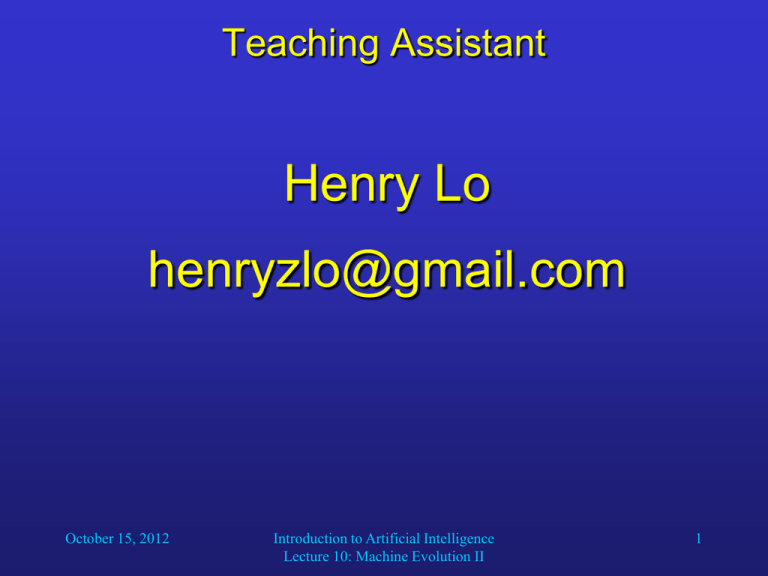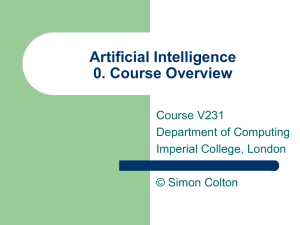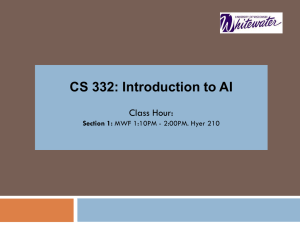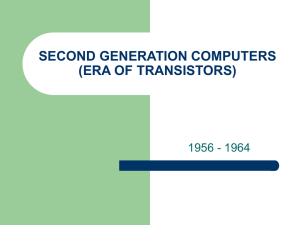PPTX
advertisement

Teaching Assistant
Henry Lo
henryzlo@gmail.com
October 15, 2012
Introduction to Artificial Intelligence
Lecture 10: Machine Evolution II
1
Genetic Programming
Instead of just varying a number of parameters, we can
evolve complete programs (genetic programming).
Let us evolve a wall-following robot in grid-space
world.
The robot’s behavior is determined by a LISP function.
We use four primitive functions:
• AND(x, y)
= 0 if x = 0; else y
• OR(x, y)
= 1 if x = 1; else y
• NOT(x)
= 0 if x = 1; else 1
• IF(x, y, z)
= y if x = 1; else z
October 15, 2012
Introduction to Artificial Intelligence
Lecture 10: Machine Evolution II
2
Genetic Programming
The robot receives sensory inputs n, ne, e, se, s, sw,
w, and nw. These inputs are 0 whenever the
corresponding cell is free, otherwise they are 1.
The robot can move either north, east, south, or
west.
In genetic programming, we must make sure that all
syntactically possible expressions in a program are
actually defined and do not crash our system.
October 15, 2012
Introduction to Artificial Intelligence
Lecture 10: Machine Evolution II
3
Genetic Programming
We start with a population of 5000 randomly created
programs and let them perform.
We let the robot start ten times, each time starting in
a different position.
Each time, we let the robot perform 60 steps and
count the number of different cells adjacent to a wall
that the robot visits.
There are 32 such cells, so our fitness measure
ranges from 0 (lowest fitness) to 320 (highest fitness).
October 15, 2012
Introduction to Artificial Intelligence
Lecture 10: Machine Evolution II
4
Genetic Programming
Example for a perfect wall-following robot program in
LISP:
October 15, 2012
Introduction to Artificial Intelligence
Lecture 10: Machine Evolution II
5
Genetic Programming
The best-performing program among the 5000
randomly generated ones:
October 15, 2012
Introduction to Artificial Intelligence
Lecture 10: Machine Evolution II
6
Genetic Programming
In generation i + 1,
• 500 individuals are directly copied from generation i
• 4500 are created by crossover operations between
two parents chosen from the 500 winners.
• In about 50 cases, mutation is performed.
October 15, 2012
Introduction to Artificial Intelligence
Lecture 10: Machine Evolution II
7
Genetic Programming
Example for a crossover operation:
Mutation is performed by replacing a subtree of a
program with a randomly created subtree.
October 15, 2012
Introduction to Artificial Intelligence
Lecture 10: Machine Evolution II
8
Genetic Programming
After six generations, the best program behaves like
this:
October 15, 2012
Introduction to Artificial Intelligence
Lecture 10: Machine Evolution II
9
Genetic Programming
And after ten generations, we already have a perfect
program (fitness 320):
October 15, 2012
Introduction to Artificial Intelligence
Lecture 10: Machine Evolution II
10
Genetic Programming
Here is a diagram showing the maximum fitness as a
function of the generation number:
October 15, 2012
Introduction to Artificial Intelligence
Lecture 10: Machine Evolution II
11
Game Player Evolution
You could simulate an evolutionary process to improve
your Isola playing algorithm.
The easiest way to do this would be to use evolutionary
learning to find the optimal weight vector in your
static evaluation function, i.e., optimal weighting for
each evaluation feature that you compute.
For example, assume that you are using the features f1
(number of neighboring squares) and f2 (number of
reachable squares).
In each case, you actually use the difference between
the value for yourself and the value for your opponent.
October 15, 2012
Introduction to Artificial Intelligence
Lecture 10: Machine Evolution II
12
Game Player Evolution
Then you could use weights w1 and w2 to compute
your evaluation function:
e(p) = w1f1 + w2f2
So the performance of your algorithm will depend on
the weights w1 and w2.
This corresponds to the example of the computer
vision algorithm with two free parameters.
Thus you could use an evolutionary process to find
the best values for w1 and w2 just like in that example.
October 15, 2012
Introduction to Artificial Intelligence
Lecture 10: Machine Evolution II
13
Game Player Evolution
But how can you determine which individuals survive
and procreate?
Well, one possibility would be to hold a tournament in
which all individuals compete (or many smaller
tournaments), and only the best n individuals will
reach the next generation, i.e., the next tournament.
The other individuals are deleted and replaced with
new individuals that use similar weights as the
winners.
This way you will evolve algorithms of better and
better performance, or in other words, you will
approach the best values for w1 and w2.
October 15, 2012
Introduction to Artificial Intelligence
Lecture 10: Machine Evolution II
14
Game Player Evolution
You could slightly modify the game package to
implement this principle of evolution.
When you have obtained the best values for w1 and
w2 (or in your case maybe w1, w2, …, w37), just
transfer these values into your original program in
the original game package.
Your program should now play significantly better
than it did prior to its evolutionary improvement.
Try it out!
October 15, 2012
Introduction to Artificial Intelligence
Lecture 10: Machine Evolution II
15
Back to “Serious” Topics…
Knowledge Representation
and Reasoning
October 15, 2012
Introduction to Artificial Intelligence
Lecture 10: Machine Evolution II
16
Knowledge Representation & Reasoning
Knowledge representation is the study of how
knowledge about the world can be represented and
what kinds of reasoning can be done with that
knowledge.
We will discuss two different systems that are
commonly used to represent knowledge in machines
and perform algorithmic reasoning:
• Propositional calculus
• Predicate calculus
October 15, 2012
Introduction to Artificial Intelligence
Lecture 10: Machine Evolution II
17
Propositional Calculus
In propositional calculus,
• features of the world are represented by
propositions,
• relationships between features (constraints) are
represented by connectives.
Example:
LECTURE_BORING TIME_LATE SLEEP
This expression in propositional calculus represents
the fact that for some agent in our world, if the
features LECTURE_BORING and TIME_LATE are
both true, the feature SLEEP is also true.
October 15, 2012
Introduction to Artificial Intelligence
Lecture 10: Machine Evolution II
18
Propositional Calculus
You see that the language of propositional calculus
can be used to represent aspects of the world.
When there are
• a language, as defined by a syntax,
• inference rules for manipulating sentences in that
language, and
• semantics for associating elements of the
language with elements of the world,
then we have a system called logic.
October 15, 2012
Introduction to Artificial Intelligence
Lecture 10: Machine Evolution II
19
The Language
Atoms:
The atoms T and F and all strings that begin with a
capital letter, for instance, P, Q, LECTURE_BORING,
and so on.
Connectives:
• “or”
• “and”
• “implies” or “if-then”
• “not”
October 15, 2012
Introduction to Artificial Intelligence
Lecture 10: Machine Evolution II
20
The Language
Syntax of well-formed formulas (wffs):
• Any atom is a wff.
• If 1 and 2 are wffs, so are
1 2 (conjunction)
1 2 (disjunction)
1 2 (implication)
1
(negation)
• There are no other wffs.
October 15, 2012
Introduction to Artificial Intelligence
Lecture 10: Machine Evolution II
21
The Language
• Atoms and negated atoms are called literals.
• In 1 2 , 1 is called the antecedent, and 2 is
called the consequent of the implication.
• Examples of wffs (sentences):
(P Q) P
P P
PPP
(P Q) (Q P)
P
• The precedence order of the above operators is
For example, P Q R means ((P) Q) R.
October 15, 2012
Introduction to Artificial Intelligence
Lecture 10: Machine Evolution II
22
Rules of Inference
We use rules of inference to generate new wffs
from existing ones.
One important rule is called modus ponens or the
law of detachment. It is based on the tautology
(P (P Q)) Q. We write it in the following way:
P
PQ
_____
Q
The two hypotheses P and P Q are
written in a column, and the conclusion
below a bar, where means “therefore”.
October 15, 2012
Introduction to Artificial Intelligence
Lecture 10: Machine Evolution II
23
Rules of Inference
Q
PQ
_____
P
P
______
Addition
PQ
PQ
_____
P
Simplification
P
Q
______ Conjunction
PQ
October 15, 2012
Modus tollens
PQ
Q R Hypothetical
_______ syllogism
PR
PQ
P
_____
Q
Introduction to Artificial Intelligence
Lecture 10: Machine Evolution II
Disjunctive
syllogism
24
Proofs
The sequence of wffs {1, 2, …, n} is called a proof
(or a deduction) of n from a set of wffs iff (if and
only if) each i in the sequence is either in or can
be inferred from one or more wffs earlier in the
sequence by using one of the rules of inference.
If there is a proof of n from , we say that n is a
theorem of the set . We use the following notation:
|_ n
In this notation, we can also indicate the set of
inference rules R that we use:
|_ R n
October 15, 2012
Introduction to Artificial Intelligence
Lecture 10: Machine Evolution II
25
Proofs
Example:
Given a set of wffs = {P, R, P Q}, the following
sequence is a proof of Q R given the inference
rules that we discussed earlier:
{P, P Q, Q, R, Q R}
Tree representation:
PQ
P
R
Q
QR
October 15, 2012
Introduction to Artificial Intelligence
Lecture 10: Machine Evolution II
26
Semantics
• In propositional logic, we associate atoms with
propositions about the world.
• We thereby specify the semantics of our logic,
giving it a “meaning”.
• Such an association of atoms with propositions is
called an interpretation.
• In a given interpretation, the proposition associated
with an atom is called the denotation of that atom.
• Under a given interpretation, atoms have values –
True or False. We are willing to accept this
idealization (otherwise: fuzzy logic).
October 15, 2012
Introduction to Artificial Intelligence
Lecture 10: Machine Evolution II
27
Semantics
Example:
“Gary is either intelligent or a good actor.
If Gary is intelligent, then he can count
from 1 to 10.
Gary can only count from 1 to 2.
Therefore, Gary is a good actor.”
Propositions:
I: “Gary is intelligent.”
A: “Gary is a good actor.”
C: “Gary can count from 1 to 10.”
October 15, 2012
Introduction to Artificial Intelligence
Lecture 10: Machine Evolution II
28
Semantics
I: “Gary is intelligent.”
A: “Gary is a good actor.”
C: “Gary can count from 1 to 10.”
Step 1:
Step 2:
Step 3:
Step 4:
Step 5:
C
IC
I
AI
A
Hypothesis
Hypothesis
Modus Tollens Steps 1 & 2
Hypothesis
Disjunctive Syllogism
Steps 3 & 4
Conclusion: A (“Gary is a good actor.”)
October 15, 2012
Introduction to Artificial Intelligence
Lecture 10: Machine Evolution II
29








